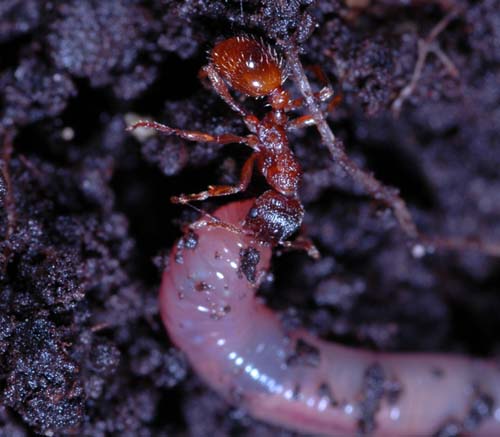A Brief Natural History of the European fire ant
Myrmica rubra
Much of what is reported here comes from Radchenko and Elmes, 2010 (Myrmica ants of the Old World) and from personal communications with Susan Horton (M.Sc Candidate at Saint Mary's University in Halifax), Dr. André Francoeur (University of Quebec), Dr. Eleanor Groden (University of Maine), and Dr. Riitta Savolainen (University of Helsinki).
Colonies of the European fire ant typically have more than one queen (reported average of 15 per colony), a trait which is common in many ant species at higher latitudes. New virgin queens (winged or possibily non-winged in this species) and males (winged) are produced in the nest in late June. Most ants reproduce via nuptial flights but this appears to be rare, or possibly limited to only the males (new paper by Barry Hicks), for this species in North America. This is very fortunate in that this limits their ability to quickly spread widely. Rather, mating occurs likely in or close to the nest and the fertlized queens, which quickly lose their wings (if they had them), are adopted by their home or nearby colony. As colony numbers grow (mature colonies contain approximately 1000 workers with queens reported to lay 200-300 eggs per year), queens walk away from the colony with a group of workers and establish new nests in the vicinity of the original nest. They do not seem to travel far, creating high densities of nests (up to 4 per sq. metre). In this manner the colony expands and monopolizes the resources of the local area, excluding competiting species of ants.
This ant prefers moist sites making tall grass, low shrubby areas, and ground under rocks, wood or yard clutter ideal. Rocks and wood in particular gain heat through the day and disperse that heat at night keeping nests warm 24 hrs a day. This heat is critical in raising the larvae quickly. In raised gardens they like the soil immediately adjacent to the wooden supporting framework.

The European fire ant attacking an earthworm
They are also commonly found in the loose soil of root wads, making plant transplants the most likely method of distributing the ant across landscapes. Given the high densities these ants achieve once established, the probablity of their being transported with soil or plants taken out of an infested area is very high.
This ant has a strong preference for sugars and can be found quickly recruiting to discarded fruit (e.g., an apple core) or onto strawberries in a garden. Following this, these ants are also common in trees where they tend aphids for their honeydew (apparently more so than in their native European range). This leads to the recommendation of sugar based Borax baits in control. Unfortunately, this ant also recruits quickly to percieved threats and as a consequence readily attacks anything disturbing the nest.
The sting of this ant has been variously described, but one description that coincides with the experience of this author, is that it is similiar to stinging nettle. The sting persists acutely for perhaps an hour or two, then leaves a small raised itchy wheal for several days. As I write this I still have two small itchy wheals from stings that are 5 days old. Some people do have more significant allergic reactions to these stings. Such a situation has already arisen in Burnaby, where stings gave rise to serious swelling requiring medical attention.
Return to European fire ant in BC Homepage
Return to Rob's Ants of BC Homepage.